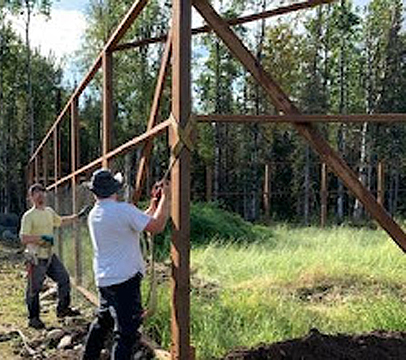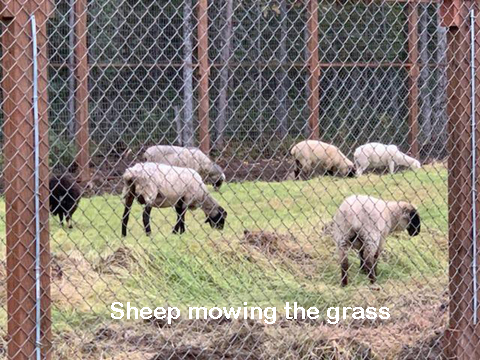MLCC Community Orchard
Planning for the orchard started in 2022 and was completed in 2023 with the planting of 20 apple trees (12 different varieties), 12 cherries trees (4 different varieties), 9 Haskaps (3 different varieties), 4 Manchurian apricots, and 20 “Honey Queen “ golden raspberries that will arrive in April ‘24. There is still space for a few more cherries. The orchard is located on the far side of the park west of the basketball court and tennis/pickleball court.
The total amount granted to the project is 22,500. Roughly 16,000 has been spent thus far, although final accounting and grant reporting has not been completed as of October 2023. We still need to purchase some irrigation apparatus and more soil amendments, as well as some continued maintenance supplies. Wood chips are still yet to be procured and spread outside the perimeter of the fence.
The raspberries and Haskaps may produce a small amount of fruit in 2024, and the cherries should begin to produce in a few years. The apples should begin to produce within 5 years. Anyone who volunteered during the project will get the first opportunity to harvest fruit. As production ramps up, the general public will be allowed to harvest during scheduled times that the fruit is ripe. Eventually, the orchard may produce enough excess fruit to be able to donate to schools or the food banks. At full production the orchard would likely produce in excess of 1500 pounds of fruit per year. To accomplish the goads of the project, MLCD will partner with Meadow Lakes Community Council and Meadow Lakes Bloomers Garden Club, and will create an Orchard Committee to delegate tasks.
“Funding for the Meadows Lakes Community Orchard was made possible by the U.S. Department of Agriculture’s (USDA) Agricultural Marketing Service through grant 21GMFSPAK1005. Its contents are solely the responsibility of the authors and do not necessarily represent the official views of the USDA. This grant is administered by the Alaska Division of Agriculture. “
Thank you for making it a reality:
The Orchard was sponsored by the Alaska Division of Agriculture, the Mat-Su Health Foundation and Mat-Su United Way as a project of Meadow Lakes Community Development, Inc.
Equipment use donated:
Steve Edwards, mid-size excavator for 3 weeks
Joseph Mabry, tractor
Ariel Cannon, flatbed trailer
Al Leonard, Skid-Steer attachments
Al Leonard, Ariel Cannon: various power toolsBrandon Stevens, Stevens Constructors: installed fence posts, only charged cost of his employees.
Joseph Mabry, Rebel’s Haven Organics: donated a tote of worms castings ($600 value)There was support from Heaton Trail Farm in the form of the loan of the 15 sheep to mow down the rye grass that was planted prior to the planting of the trees.
Volunteers donated 150 hours preparing the site, building the fence and planting. This does not include the hours of meetings and planning time. Volunteers include: Ariel Cannon, Al Leonard, Patti Fisher, Tristan Hale, Lewis Barrows, Camden Yehle, Jack Yehle, Steve Edwards, Dewey Bittler, Daniel Bittler, Tom Katkus, Keith, Joan Tovsen, Jerry Walton, Joseph Mabry, Chris and John.
Prepping the land
To build the Orchard, an excavator with toothed bucket was used to grub the area to remove willow/aspen/birch brush and roots. The skid-steer was used with a rock bucket to transport rocks and roots out of the site. After the site was cleared, the orchard fence line was laid out and fence post locations marked. Clearing of the sports field left a large overburden and stump row adjacent to the area planned for the orchard. This overburden was utilized as base soil for the project. An excavator and mobile soil screen was used to classify and spread the soil on the project site.
Building the Moose Proof Fence
As the fence posts were installed, the skid steer transported topsoil into the orchard. Approximately 400 CU. yards were transported in. Annual Rye was hydroseeded. After the fence was completed, sheep were brought in to eat the grass. After the sheep ate the grass, the plants were installed, with a wheelbarrow full of compost/sand/topsoil mix for each plant, as well as a shovel full of the worm castings. The fence is 10’ high.
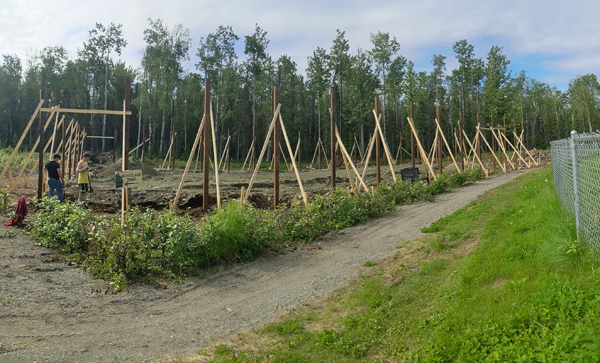
Planting the Rye Grass and "Mowing" the Grass
A cover crop of rye grass was hydroseeded immediately to help with noxious weed control. Heaton Trail Farm's sheep mowed down the rye grass prior to planting the trees.
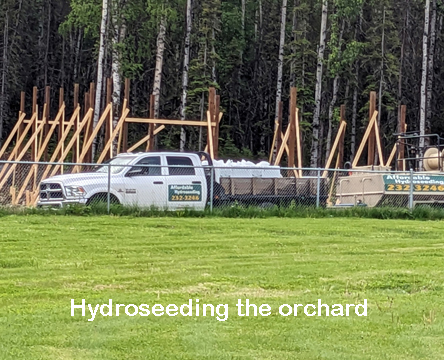
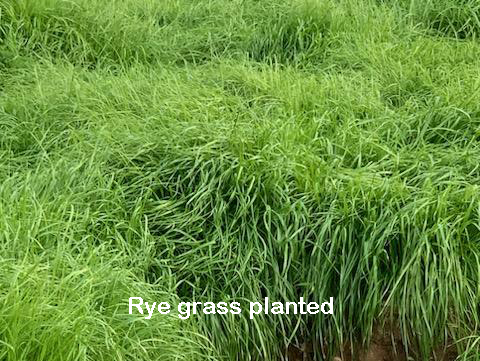
Planting the Trees
20 apple trees (12 different varieties), 12 cherries trees (4 different varieties), 9 Haskaps (3 different varieties), and 4 Manchurian apricots were planted, with 20 “Honey Queen “ golden raspberries arriving in April ‘24. There is still space for a few more cherries. Irrigation will be provided via the upgraded Sports Field Irrigation System.
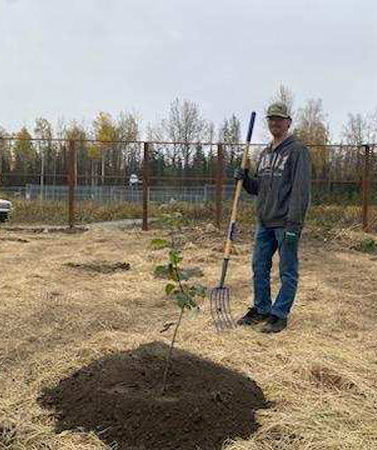
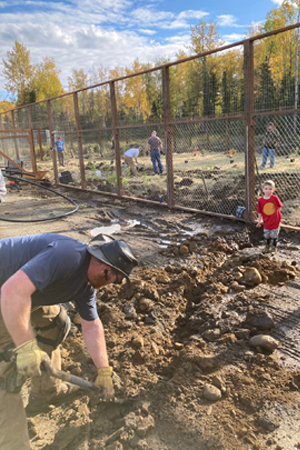
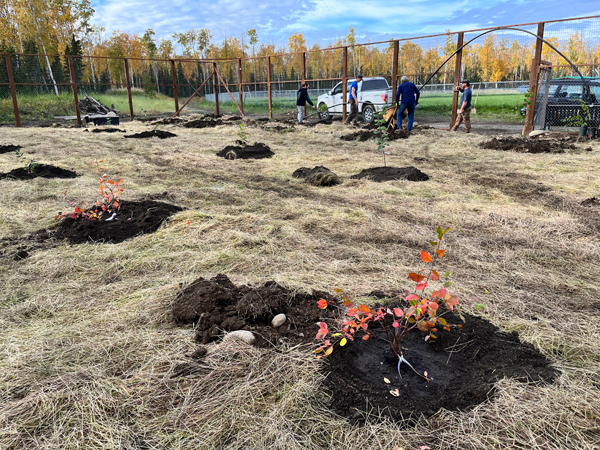
10/4/23 Frontiersman rticle - Meadow Lakes brings orchard idea to ‘fruition’ | Valley Life |
by Katie Stavick, Frontiersman
frontiersman.com
Ariel Cannon, President of the Meadow Lakes Community Development, got the idea of planting a fruit orchard after seeing grants available through the Alaska Department of Agriculture for food security.
Tucked in a little corner of Meadow Lakes, volunteers gathered, bringing their shovels, rakes, and wheelbarrows all in the name of planting a new orchard to help bring fruit to tables within the community.
Ariel Cannon, President of the Meadow Lakes Community Development, said that he was inspired to create the project after seeing a grant application through the USDA last spring, and the idea came to ‘fruition’ from there.
“The state’s division of agriculture had the grant program, ‘Micro Grants for Food Security,’ and we got that grant, along with another grant from the Mat-Su Health Foundation, as well as the United Way, which is how we’re able to do this,” said Cannon.“I think this is a fantastic idea. It’s had amazingly good reception because a lot of people have been asking what’s happening with all the equipmentand fences, and every time I
tell them we’re building an orchard, people get real excited,” says Camden Yehle, President of the Meadow Lakes Community Council (MLCC), who was digging holes while her son Jack was helping plant some of the fruit trees.
The project relies heavily on the volunteer efforts from the people of Meadow Lakes, young and old, who have volunteered the time, effort, and sheep when needed. Especially when the field that was chosen as the best spot for the orchard proved too much for a rototiller.
“The man running the machine came to us and said he had a different idea, and asked if he could bring his sheep over to mow the field down, and just like that we had 15 sheep here to browse the field down,” recounts Yehle. “It would have been quite the planting project without that.”
There was also worry about what to do about moose who might find the orchard too tempting a treat to pass up. Cannon and crew have installed a tall fence around the property, also applying some Alaskan resourcefulness to keep costs down.
“That was the main expense of the grant, that being the materials. We were able to hire a contractor to erect all the fence posts, get them lined and braced, it’s pretty stout. And then we had rolls of fencing leftover from the field and park development, so we were able to get it done,” says Cannon.
Yehle added that a berm left from constructing the ballfields years ago provided the top soil needed to go on top of the ground and help nourish the trees and bushes. “We had this cache of top soil right there, just waiting for something, so we didn’t need to get top soil. Just a tractor to move it. And just like that, we were ready for planting.”
Once the trees get a little mature and start bearing fruit, the community will be invited to share in the bounty, although first dibs will go to the volunteers helping to build the orchard.
“Eventually, they will produce more than enough for everyone. We’ll have open days when everything’s ripe and let people in.”
The orchard consists of 20 apple trees, several Evans cherry bush trees, apricot trees, golden raspberries, and Cannon says they are still trying to getseveral other bush cherry varieties.
Volunteers will continue to assist with the project, making sure the young plants will be watered and maintaining the orchard over the fall and winter season. Meanwhile, everyone is excited to see what the trees ‘produce.’
“It’s exciting, we have a great spot for it, and it fills a need.”
Meadow Lakes
Community Council
The Lakes... The Land... The People
>


